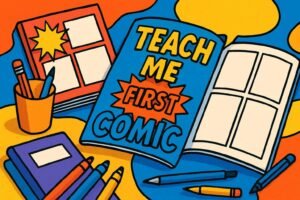The Magic of Comics: An Introduction to ‘Teach Me First Comic’
Comics have emerged as a powerful medium for storytelling and artistic expression, captivating audiences across diverse age groups and backgrounds. Through a unique combination of art and text, comics engage readers in a way that other forms of literature may not replicate. The ‘Teach Me First Comic’ concept plays a pivotal role in introducing aspiring comic artists and writers to the fundamental elements of this captivating art form, serving as a crucial stepping stone to unlocking their creative potential.
Within the realm of comics, there exists an array of genres, from superhero narratives to slice-of-life stories, each employing distinct techniques to convey emotions and themes. Understanding how to navigate these genres is imperative for budding creators, as it allows them to find their unique voice and style. The ‘Teach Me First Comic‘ framework encourages individuals to explore different genres, highlighting the versatility of comics as a storytelling medium.
Engagement is critical when crafting a comic, and several elements contribute to a comic’s overall allure. Effective dialogue, dynamic pacing, and well-developed characters can enthrall readers and draw them deeper into the narrative. Moreover, visuals play an essential role in storytelling, providing context and adding layers of meaning that can enhance the reader’s experience. Illustrations not only complement the text but can also convey emotions and actions that words alone may struggle to express.
As we delve deeper into the ‘Teach Me First Comic’ techniques in subsequent sections, the focus will be on practical advice that empowers creators to harness their imagination. By fostering creativity and understanding the intricacies of comic storytelling, aspiring artists and writers can cultivate their skills, ultimately contributing to this vibrant and dynamic medium.
Essential Techniques for Comic Creation
Creating a captivating comic requires a combination of various fundamental techniques that serve as the backbone of the art form. These techniques encompass character design, narrative structure, panel layout, and dialogue writing, each contributing to the overall impact of the comic.
Character design forms the core of any comic project. Engaging characters with visually distinct features not only grab the reader’s attention but also help to convey their personality and role in the story. Begin by sketching multiple concepts for your characters, considering their background, motivations, and traits. Create unique silhouettes and expressions to make them memorable, harnessing the principle of “less is more” to ensure they are not overloaded with details.
Next, narrative structure plays a critical role in guiding the reader through your comic. A well-constructed plot adheres to a classic structure comprising exposition, rising action, climax, falling action, and resolution. Organizing your story in this manner helps in crafting a clear and engaging storyline that fuels interest. Additionally, think about the pacing—strategically deciding where to linger on certain panels can heighten emotional impact or build tension.
Panel layout is another vital technique in comic creation. The way you arrange panels significantly influences the reading experience. Experiment with various configurations to create rhythm and flow. For instance, wider panels can represent significant moments, while smaller panels can quicken the pace during action scenes. Use white space effectively; it can guide the reader’s eye and enhance the clarity of the narrative.
Finally, mastering dialogue writing is essential for character development and advancing the plot. Dialogue should reflect each character’s voice and serve a purpose in the story. Keep it natural and succinct; unnecessary words can disrupt the reader’s immersion. Balancing dialogue with visual storytelling will ensure that your readers are both informed and engaged.
These essential techniques equip aspiring creators with a pathway to navigate the art of comic-making. With practice, one can refine these skills and embark on their journey by utilizing the ‘Teach Me First Comic’ approach.

Building Your First Comic: A Step-by-Step Guide
Creating your first comic is an exciting journey that requires careful planning and creativity. To begin the process, start by brainstorming ideas. Think about your interests, experiences, or themes that resonate with you. Jot down a list of potential concepts, characters, and settings. This brainstorming phase is crucial as it forms the foundation of your story and can incorporate elements from a ‘teach me first comic’ perspective.
Once you have your ideas, the next step is scripting. A script outlines the dialogue, actions, and scene descriptions. Create a structured format that includes panel breakdowns, which helps in visualizing how each scene will progress. This structured approach is essential for beginners, as it acts as a roadmap throughout the comic-making process.
After scripting, it’s time for sketching. Start with rough sketches to lay out the composition and flow of your comic panels. At this stage, focus on the visual storytelling aspects rather than the details. Your sketches should capture the essence of your narrative while maintaining an openness to iteration and refinement. In fact, feedback during this phase can lead to significant improvements.
Following the sketches, move on to inking your work. Inking brings clarity and definition to your drawings, making them pop on the page. Choose the right tools that suit your style, whether digital or traditional. Once the inking is complete, the final step is coloring. Color adds depth and emotion to your comic, enhancing the reader’s experience. Experiment with different palettes that align with the mood of each scene.
Throughout this creative process, remember that art is subjective and iterative. Don’t hesitate to seek feedback from peers or mentors as it can provide valuable insights and help refine your work. Engaging with others in the comic-making community can inspire you and validate your efforts. In conclusion, following these steps with a focus on feedback and iteration will equip you with the skills needed for your first comic adventure. A ‘teach me first comic’ approach not only facilitates learning but also encourages a deeper understanding of the craft.
Sharing Your Comic: Tips for Publication and Promotion
To successfully share your comic with a wider audience, it is essential to explore the available publication and promotion avenues. One popular route is self-publishing, which allows creators full control over the process. With various platforms such as Lulu or Blurb, you can print physical copies or create digital versions readily available for purchase. This approach enables artists to maintain their unique vision while offering flexibility in distribution.
Digital platforms have gained immense popularity, providing unique opportunities for aspiring comic artists. Websites like Webtoon and Tapas allow creators to share their work weekly, encouraging reader engagement. Additionally, creating a dedicated website or blog is another effective method for showcasing your comic. This not only allows for direct interaction with fans but also establishes a personalized platform for your work, creating a deeper connection with your audience.
For those considering traditional publishing, it is crucial to research publishers that focus on comics or graphic novels. Preparing a compelling pitch, including sample pages and a well-articulated synopsis, increases the chances of getting noticed. Networking with professionals at conventions or through online communities can also provide valuable connections within the publishing industry.
Effective marketing strategies are vital to promote your comic successfully. Leveraging social media platforms like Instagram, Twitter, and Facebook can help build an audience before the comic’s release. Utilize storytelling through posts, share behind-the-scenes content, or even host online events to foster community engagement. Collaborating with fellow creators for cross-promotion or participating in online challenges can amplify your reach.
In conclusion, the journey of the ‘Teach Me First Comic‘ doesn’t stop at completion. By employing self-publishing or traditional routes, creating a strong online presence, and actively engaging with your community, you can effectively share your comic with the world.


